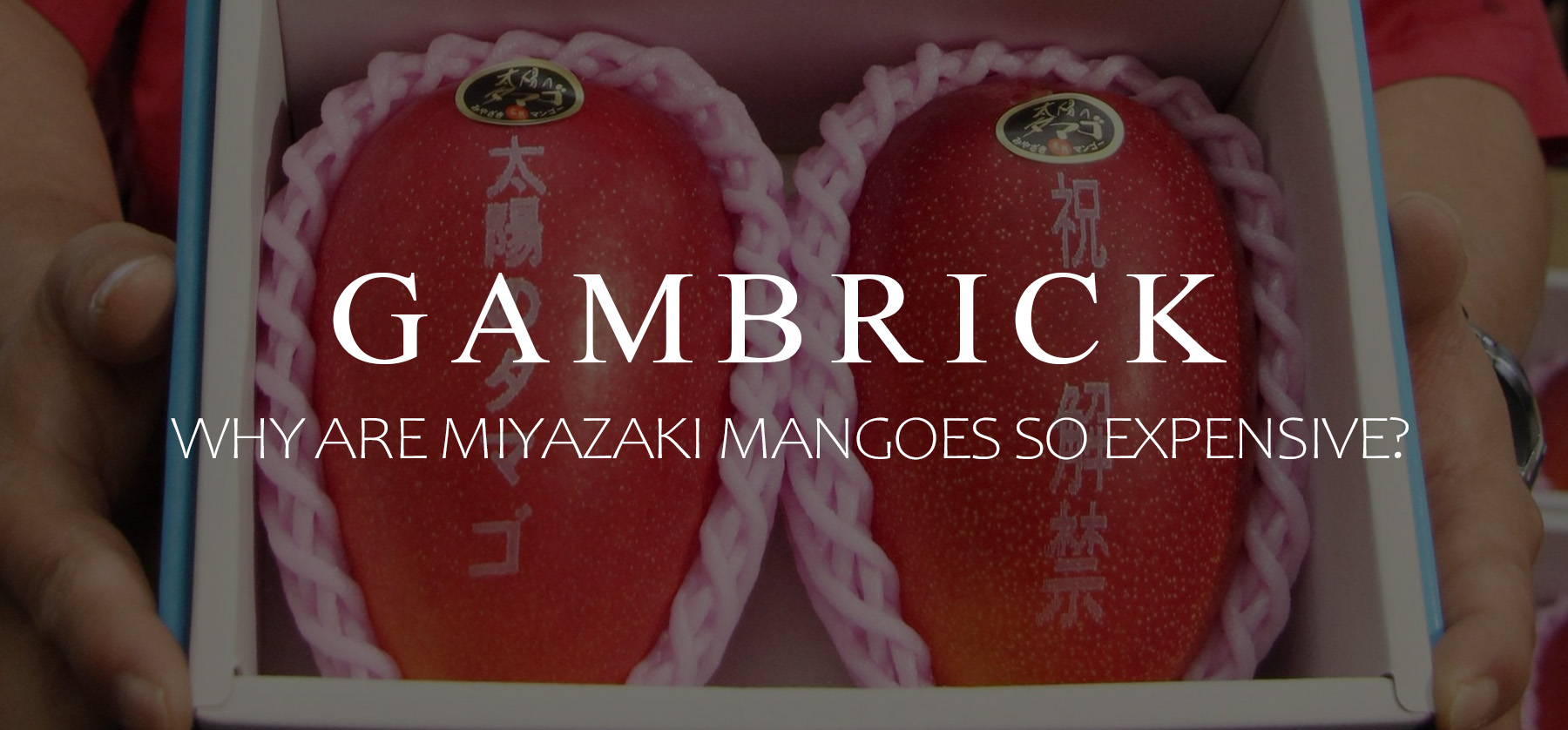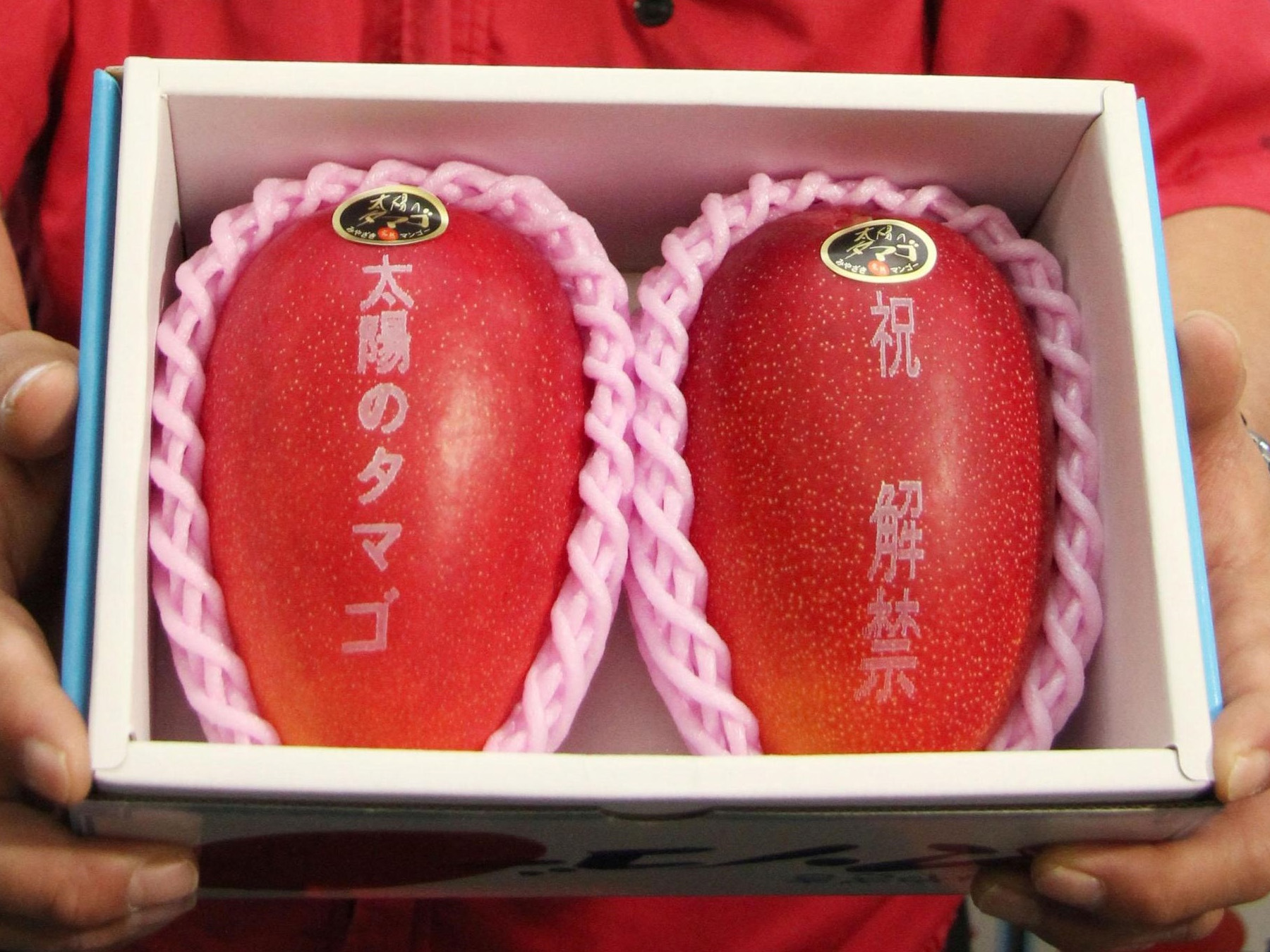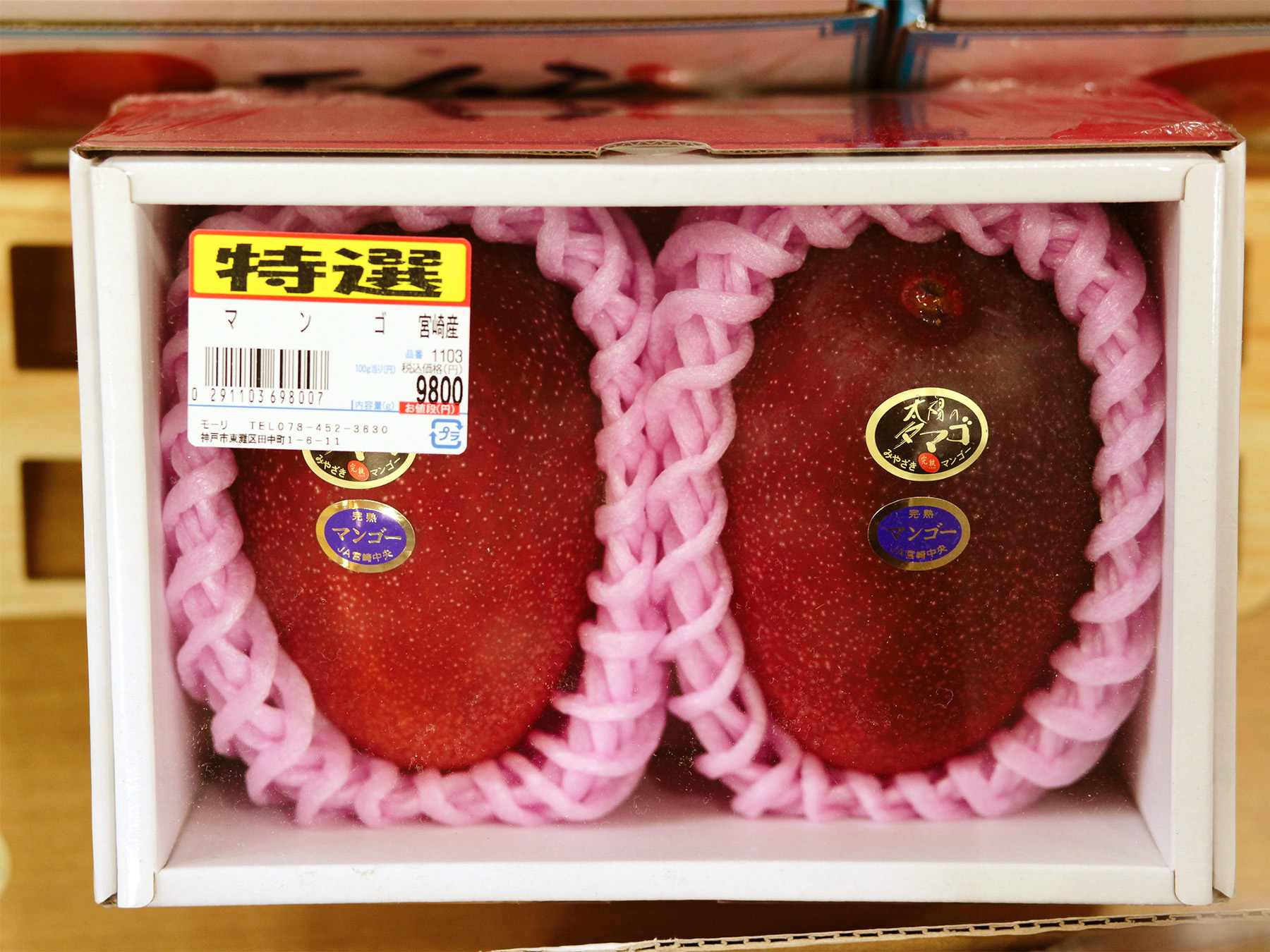Why Are Miyazaki Mangoes So Expensive?
Miyazaki mango, also known as egg of the sun, is a type of “Irwin” mango known for their unique ruby red color, sweet taste and high price. The best Mangoes are grown on the island of Kyushu, Japan. Every April, mangoes are harvested and auctioned off at the Miyazaki Central Wholesale Market. Some selling for over $2,000 per Mango. But most sell for around $50 each. Still a very high price for a single fruit. Farmers dedicate an entire year to growing their mangoes without any guarantee they’ll fetch a high price. Miyazaki Mangoes are so expensive because of the extreme amount of care, labor and time it takes to grow them. Only about 10% of the mangoes grown each year make it to auction. And only a fraction of those sell for top dollar.
Before being selected for auction, a Mango must be perfect both inside and out. They’re difficult to grow so not all mango farmers are successful. It takes time, experience and a bit of luck to grow fruit that will bring high dollars at auction. Mango auctions are not like buying fruit at the grocery store. It’s very rare to get a perfect mango and they’re only sold once a year. So buyers are willing to pay a lot.
Many people say eating a Miyazaki mango is like jelly in your mouth. You can eat them with the skin on or off and they’re said to melt in your mouth. Only mangoes with the highest sugar content of at least 15% and weighing a minimum 350 grams with unblemished skin and perfect color are considered high enough quality to be auctioned.
Miyazaki Mangoes are considered a luxury in Japan and a delicacy which is why fruits have sold for over $2,000.
What Are Miyazaki Mangoes
Miyazaki mango is a type of “Irwin” mango. They’re often referred to as an apple mango because of their unique ruby red color.
Miyazaki mangoes have the second largest production in Japan. They have to pass strict standards before being sold at market. 90% of the mangoes are sold at generic food and fruit stores. But the top 10% are auctioned off for top dollar.
Irwin mangoes are grown in other parts of the world for much lower prices. India, for example, has started growing Miyazaki mangoes but haven’t yet been able to reproduce the same high quality fruit as Japan.
The best mangoes are bright red on the outside with a yellow bottom and golden yellow inside. They have both a sweet and sour taste.
The high price Miyazaki mangoes sell for at auction reflects the care and time farmers take when growing the fruit.
If the fruit isn’t treated properly and grown in a controlled environment, then they will not bear more than 2-3 fruits. Such a low yield is not economical or profitable. The best way to grow them is in a protected greenhouse.
The high price tag of the fruit is partially due to the time and care that goes into growing them. To get the perfect ruby red color, Japanese farmers surround the mangoes with small nets that allow sunlight in while preventing gravity from plucking the fruit too soon.
The taste has been described as “mango flavored candy with hints of pineapple and coconut”. It has low fiber and a lot of juice with both a sweet and sour flavor.
How Miyazaki Mangoes Are Grown
Miyazaki mangoes are grown indoors. Bees are used to pollinate flowering plants. This helps the mangoes grow larger than they normally would.
Growing the fruit indoors increases each plants yield. In the wild, a mango plant will only grow a handful of fruits. However, when grown and protected indoors, a tree can grow over 100 pollinated fruits per year.
Fruits that bees do not pollinate stay small and are not suitable for auction. However, when pollinated by a bee, fruits grow larger with more sugar.
If a tree keeps growing it can survive as long as 35 years.
Even if a fruit is pollinated by a bee, it doesn’t mean it will qualify for auction. Only fruits that are in good shape, visibly contain pits and are the right size will be given a chance. Generally only the top 10% of mangoes grown will qualify for auction. And of those 10% only a small handful will bring top dollar.
To successfully grow mangoes, everything in the greenhouse needs to run smoothly. Temperature must be constant, the room ventilated and the air dehumidified.
Each mango is tied up with a mesh to prevent gravity from pulling it off the tree. This helps them stay on the tree longer which increases their size.
A single green house can grow 10,000 fruits per year. However most will not earn top dollar at auction and sell for around $50 per fruit.
After flowering, fruiting, harvesting and auctioning, trees are cut back and prepared for the next season. This is called pruning.
Miyazaki Mangoes Require Lots Of Sunlight
Sunlight is very important to growing Miyazaki mangoes. It’s only when they get just the right amount of sunlight that they grow bright red and the sugar content increases.
Fruits in the shade have poor color, often greenish, and a lower sugar content. This is not good enough to fetch a high price at auction.
If a mango slumps into the shade, farmers will tie the plant up until the fruit is back in the sunlight. This is no easy task when your caring for a farm with hundreds of mangoes. Each one needing the right amount of sun to grow red and sweet.
To make sure each part of the plant receives sunlight, reflectors are placed below the fruit to bounce light upwards. This helps grow the mango from all directions. Reflectors enhance the fruits colors even down to their lowest point.
A fruit starts a greenish color, then gradually turns purple. When adequate sunlight is present the purple areas eventually turn a bright red. This is the color auction goers want to see.
The bottom of the fruit will start green but eventually turn a very nice shade of yellow when ripe.
Reflective panels make sure every area of the fruit is as red as possible.
To get the highest price at auction, each fruit has to pass strict quality requirements. Each fruit must be at least 350 grams and contain at least 15% sugar. This is made possible when mangoes are grown indoors and properly cared for. When mangoes are grown in the wild they don’t achieve this large size or high sugar content.
Where Miyazaki Mangoes Come From
Miyazaki mangoes are grown on the Kyushu island of Japan. But they come from the Irwin mango which are cultivated in Florida, USA.
The mangoes came to Japan in the mid-80s to grow in warmer climates.
These mangoes are prized for both their unique bright red color and high sugar content. A top mango can have 15 per cent more sugar than their counterparts. This is very rare when compared to other mangoes in the same family.
If grown in optimum conditions, a Miyazaki mangoes can weigh around 350 grams and develop their distinct red color. This takes a lot of time, care and a well maintained greenhouse.
Miyazaki mangoes are grown in other parts of the world than Japan. The biggest competitor being India. However, no other country than Japan has yet produced the high quality fruits sold at auction.
Miyazaki Mango Auction
Only about 10% of Miyazaki Mangoes grown are good enough to be sold at auction. But only a small fraction of that 10% fetch a high price.
Once the mangoes reach auction they’re inspected and graded.
The first inspection is done by eye.
Each fruit is inspected to ensure they’re red throughout with no green at the bottom. They are then placed on a conveyor belt which takes them to the next inspection station.
Next, a machine analyzes and sorts them by sugar content, weight and size. There are 3 main attributes a fruit must meet in order to be sold at auction.
- Sugar content must be at least 15%
- Must weight more than 350 grams
- Must be more than 2L in size
Taiyo No Tamago means egg of the sun. To attain this title the fruit must meets all 3 requirements.
Only about 10% of the mango grown each year earn the Taiyo no Tamago name and make it to Miyazaki central wholesale market auction.
Auctions are conducted in Yen, not U.S. dollars.
In past auctions, the top mangoes have sold for over $2,000 a fruit.
The best Miyazaki Mangoes are so expensive because of how rare they are. Only about 10% of mangoes grown earn a high enough grade to be auctioned. And of those 10%, only a small amount fetch top dollar. The high price reflects not only the scarcity, but also how much time, effort and care goes into growing them.
Miyazaki Mango Grades
Once inspected, mangoes are sorted into 5 grades.
- AA: Red superior Taiyo no Tamago. A perfect mango.
- A: Blue superior Taiyo no Tamago. Slightly less than the AA but still a near perfect mango.
- B: Good size but with some imperfections and slightly more yellow at the base
- C: Smaller with surface imperfections and yellow at the base
- Substandard: Very small with lots of yellow at the base
Only about 10% of mangoes inspected will receive the Taiyo no Tamago, egg of the sun, title.
Taiyo no Tamago fruits are then packaged and moved for sale in the market auction.
There are only about 5-6 farms that ship mango to Miyazaki Central Wholesale Market Auction each year. All competing for the best mango and the highest price.
After flowering, fruiting, harvesting and auctioning, the fruit is then eaten or taken to retail stores to be displayed and sold.
Despite bad economic times, the best mangoes still sell for top dollar at auction.
What Do Miyazaki Mangoes Taste Like?
The best Miyazaki Mangoes sold at auction have a very sweet but slightly sour taste. Most people describe them as mango flavored candy with hints of pineapple and coconut. They’re very juicy with a low fiber content. You can eat them with the skin on or off. But with the skin off they feel like jelly in your mouth exploding with sweetness and juices.
Lower quality Miyazaki mangoes that don”t make it to auction are less sweet and juicy. They’re smaller with a lower sugar content.The taste is similar but less intense.
To be auctioned off at the Miyazaki Central Wholesale Market Auction a mango must first attain the title Taiyo no Tamago which means egg of the sun.
To achieve the title, a mango must receive a grade of AA or A. This means a size of at least 2L, a weight of 350 grams and at least 15% sugar content.
The best Miyazaki Mangoes are so expensive because they’re rare. Compared to other mangoes, the best are larger and sweeter with a more intense flavor and more juice.
Summary: Why Are Miyazaki Mangoes So Expensive?
Miyazaki mango, also known as egg of the sun, is a type of “Irwin” mango known for their unique ruby red color, sweet taste and high price. The best Mangoes are grown on the island of Kyushu, Japan. Every April, mangoes are harvested and auctioned off at the Miyazaki Central Wholesale Market. Some selling for over $2,000 per Mango. But most sell for around $50 each. Still a very high price for a single fruit. Farmers dedicate an entire year to growing their mangoes without any guarantee they’ll fetch a high price. Miyazaki Mangoes are so expensive because of the extreme amount of care, labor and time it takes to grow them. Only about 10% of the mangoes grown each year make it to auction. And only a fraction of those sell for top dollar.
Before being selected for auction, a Mango must be perfect both inside and out. They’re difficult to grow so not all mango farmers are successful. It takes time, experience and a bit of luck to grow fruit that will bring high dollars at auction. Mango auctions are not like buying fruit at the grocery store. It’s very rare to get a perfect mango and they’re only sold once a year. So buyers are willing to pay a lot.
Many people say eating a Miyazaki mango is like jelly in your mouth. Only mangoes with the highest sugar content of at least 15% and weighing a minimum 350 grams with unblemished skin and perfect color are considered high enough quality to be auctioned.
Miyazaki Mangoes are considered a luxury in Japan and a delicacy which is why fruits have sold for over $2,000.
If you have any questions about why Miyazaki Mangoes are so expensive, email any time.
























